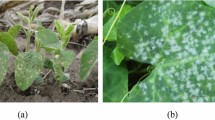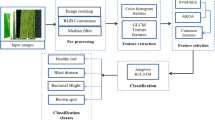Abstract
Agricultural production is considered the primary source of the economy of many countries. Tomato and Potatoes are the most sensitive and consumable vegetables worldwide. However, during the growth of these crops, they suffer from many leaf diseases, which lead to loss of productivity and economy of the farmers. Many farmers detect and find plant diseases that are more time-consuming, expensive, and require expert decisions following the naked eye method. Therefore, early and accurate diagnosis of Tomato and Potato crops leaf diseases plays a vital role in sustainable agriculture. So, this research paper proposes an efficient leaf disease classification model based on computer vision techniques. The proposed Adaptive Deep Neural Network (ADNN) leaf disease classification method is a hybrid model which combines an optimized long short-term memory (OLSTM) and convolution neural network (CNN). The weight values supplied in the LSTM classifier are optimally selected using the Adaptive Raindrop Optimization algorithm. The handcrafted features are extracted from the segmented image and fused with the hybrid deep neural network to improve the classifier performance. The ADNN method consists of five steps: preprocessing, feature extraction, segmentation, handcrafted feature extraction, and classification. At first, the images are given to the preprocessing stage to remove the noise from leaf images. Then, the image-affected portion is segmented using an enhanced radial basis function neural network. After the segmentation process, the segmented image is given as an input to the adaptive deep neural network (ADNN) that classifies various types of diseases in the Potato and Tomato leaves. The efficiency of the ADNN model based on the OLSTM-CNN approach is determined concerning multiple metrics, namely Accuracy, Precision, Recall, F-measure, Specificity, and Sensitivity. The ADNN model achieved the best Accuracy of 98.02% for Tomatoes and 98% for Potatoes. The ADNN is compared with existing state-of-the-art CNN, LSTM, ResNet50, and MobileNet techniques. The performance analysis proved that the ADNN model improved efficiency in terms of all metrics and methods.






























Similar content being viewed by others
References
Agarwal M, Gupta SK, Biswas K (2020) Development of efficient CNN model for tomato crop disease identification. Sustain Comput Inform Systems 28:100407
Ashwinkumar S, Rajagopal S, Manimaran V, Jegajothi B (2022) Automated plant leaf disease detection and classification using optimal mobilenet based convolutional neural networks. Mater Today Proc 51:480–487
Atila Ü, Uçar M, Akyol K, Uçar E (2021) Plant leaf disease classification using efficientnet deep learning model. Ecol Inform 61:101182
Chao X, Sun G, Zhao H, Li M, He D (2020) Identification of apple tree leaf diseases based on deep learning models. Symmetry 12:1065
Chen X, Zhou G, Chen A, Yi J, Zhang W, Hu Y (2020) Identification of tomato leaf diseases based on combination of abck-bwtr and b-arnet. Comput Electron Agric 178:105730
Diseases P, symptoms (2023a) Potato: diseases and symptoms. https://vikaspedia.in/agriculture/crop-production/integrated-pest-managment/ipm-for-vegetables/ipm-strategies-for-potato/potato-diseases-and-symptoms
Diseases T, symptoms (2023b) Tomato: diseases and symptoms. https://vikaspedia.in/agriculture/crop-production/integrated-pest-managment/ipm-for-vegetables/ipm-strategies-for-tomato/tomato-diseases-and-symptoms
Esgario JG, Krohling RA, Ventura JA (2020) Deep learning for classification and severity estimation of coffee leaf biotic stress. Comput Electron Agric 169:105162
Farooqui NA, Mishra AK, Mehra R (2022) Concatenated deep features with modified lstm for enhanced crop disease classification. Int J Intell Rob Appl, 1–25
Fuentes A, Yoon S, Kim SC, Park DS (2017) A robust deep-learning-based detector for real-time tomato plant diseases and pests recognition. Sensors 17:2022
Gadekallu TR, Rajput DS, Reddy MPK, Lakshmanna K, Bhattacharya S, Singh S, Jolfaei A, Alazab M (2021) A novel PCA-whale optimization-based deep neural network model for classification of tomato plant diseases using GPU. J Real-Time Image Process 18:1383–1396
Geetharamani G, Pandian A (2019) Identification of plant leaf diseases using a nine-layer deep convolutional neural network. Comput Electric Eng 76:323–338
Guo Y, Zhang J, Yin C, Hu X, Zou Y, Xue Z, Wang W (2020) Plant disease identification based on deep learning algorithm in smart farming. Discrete Dyn Nature Soc 2020:1–11
Hassan SM, Maji AK, Jasiński M, Leonowicz Z, Jasińska E (2021) Identification of plant-leaf diseases using CNN and transfer-learning approach. Electronics 10:1388
Healthline (2023a) Health and nutrition benefits of potatoes. https://www.healthline.com/nutrition/benefits-of-potatoes/
Healthline (2023b) Tomatoes 101: nutrition facts and health benefits. https://www.healthline.com/nutrition/foods/tomatoes/
Kaggle (2020) Tomato leaf dataset. https://www.kaggle.com/datasets/kaustubhb999/tomatoleaf/
Kaggle (2021) Potato leaf dataset. https://www.kaggle.com/datasets/muhammadardiputra/potato-leaf-disease-dataset/
Kaya Y, Gürsoy E (2023) A novel multi-head cnn design to identify plant diseases using the fusion of rgb images. Ecol Inform 101998
Lee T-Y, Lin I-A, Yu J-Y, Yang J-M, Chang Y-C (2021) High efficiency disease detection for potato leaf with convolutional neural network. SN Comput Sci 2:297
Liu B, Tan C, Li S, He J, Wang H (2020) A data augmentation method based on generative adversarial networks for grape leaf disease identification. IEEE Access 8:102188–102198
Mateen M, Wen J, Nasrullah N, Sun S, Hayat S (2020) Exudate detection for diabetic retinopathy using pretrained convolutional neural networks. Complexity 2020:1–11
Math RM, Dharwadkar NV (2022) Early detection and identification of grape diseases using convolutional neural networks. J Plant Dis Prot 129:521–532
Mohameth F, Bingcai C, Sada KA (2020) Plant disease detection with deep learning and feature extraction using plant village. J Comput Commun 8:10–22
Mukti IZ, Biswas D (2019) Transfer learning based plant diseases detection using resnet50. In 2019 4th international conference on electrical information and communication technology (EICT) pp. 1–6. IEEE
Odum EP, Barrett GW et al (1971) Fundam Ecol, vol 3. Saunders, Philadelphia
Omeer AA, Deshmukh RR (2021) Improving the classification of invasive plant species by using continuous wavelet analysis and feature reduction techniques. Ecol Inform 61:101181
Panigrahi KP, Das H, Sahoo AK, Moharana SC (2020) Maize leaf disease detection and classification using machine learning algorithms. In progress in computing, analytics and networking: proceedings of ICCAN 2019 pp. 659–669. Springer
Patil MA, Adamuthe AC, Umbarkar A (2020) Smartphone and iot based system for integrated farm monitoring. In techno-societal 2018: proceedings of the 2nd international conference on advanced technologies for societal applications Vol 1 pp 471–478. Springer
Patil MA, Manohar M (2022) Enhanced radial basis function neural network for tomato plant disease leaf image segmentation. Ecol Inform 70:101752
Patil MA, Manohar M (2023) A comprehensive review on crop disease prediction based on machine learning and deep learning techniques. In third congress on intelligent systems: proceedings of CIS 2022, Vol 1 pp 481–503. Springer
Rashid J, Khan I, Ali G, Almotiri SH, AlGhamdi MA, Masood K (2021) Multi-level deep learning model for potato leaf disease recognition. Electronics 10:2064
Roy AM, Bhaduri J, Kumar T, Raj K (2023) Wildect-yolo: an efficient and robust computer vision-based accurate object localization model for automated endangered wildlife detection. Ecol Inform 75:101919
Rubio L, Galipienso L, Ferriol I (2020) Detection of plant viruses and disease management: relevance of genetic diversity and evolution. Front Plant Sci 11:1092
Sai Reddy B, Neeraja S (2022) Plant leaf disease classification and damage detection system using deep learning models. Multimed Tools Appl 81:24021–24040
Saleem MH, Potgieter J, Arif KM (2020) Plant disease classification: a comparative evaluation of convolutional neural networks and deep learning optimizers. Plants 9:1319
Sambasivam G, Opiyo GD (2021) A predictive machine learning application in agriculture: cassava disease detection and classification with imbalanced dataset using convolutional neural networks. Egypt Inform J 22:27–34
Singh S, Gupta S, Tanta A, Gupta R (2022) Extraction of multiple diseases in apple leaf using machine learning. Int J Image Graph 22:2140009
Sujawat GS et al (2021) Application of artificial intelligence in detection of diseases in plants: A survey. Turk J Comput Math Edu (TURCOMAT) 12:3301–3305
Tarek H, Aly H, Eisa S, Abul-Soud M (2022) Optimized deep learning algorithms for tomato leaf disease detection with hardware deployment. Electronics 11:140
Tivy J (2014) Agric Ecol. Routledge
Vishnoi VK, Kumar K, Kumar B (2021) Plant disease detection using computational intelligence and image processing. J Plant Dis Prot 128:19–53
Zhao S, Peng Y, Liu J, Wu S (2021) Tomato leaf disease diagnosis based on improved convolution neural network by attention module. Agriculture 11:651
Acknowledgements
The Department of CSE supports this work, School of Engineering and Technology, Christ(Deemed to be University), Kengeri Campus, Bangalore, India, and the Department of CSE, G. Narayanamma Institute of Technology and Science, Hyderabad, Telangana, India, which includes non-financial support.
Funding
This work supports by the Department of CSE, Christ(Deemed to be University) School of Engineering and Technology, Kengeri Campus, Bangalore, India, and the Department of CSE, G. Narayanamma Institute of Technology and Science, Hyderabad, Telangana, India, which includes non-financial support.
Author information
Authors and Affiliations
Corresponding author
Ethics declarations
Conflict of Interest
The authors declare that they have no known competing financial interests or personal relationships that could have appeared to influence the work reported in this paper.
Additional information
Publisher's Note
Springer Nature remains neutral with regard to jurisdictional claims in published maps and institutional affiliations.
Rights and permissions
Springer Nature or its licensor (e.g. a society or other partner) holds exclusive rights to this article under a publishing agreement with the author(s) or other rightsholder(s); author self-archiving of the accepted manuscript version of this article is solely governed by the terms of such publishing agreement and applicable law.
About this article
Cite this article
Patil, M.A., Manur, M. Sensitive crop leaf disease prediction based on computer vision techniques with handcrafted features. Int J Syst Assur Eng Manag 14, 2235–2266 (2023). https://doi.org/10.1007/s13198-023-02066-0
Received:
Revised:
Accepted:
Published:
Issue Date:
DOI: https://doi.org/10.1007/s13198-023-02066-0





